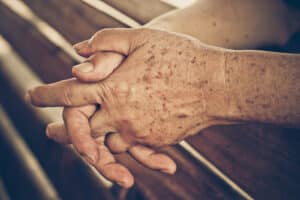
Aging produces a lot of changes in the body. It seems like every part of the body experiences changes due to age, and the skin is no exception. As people age they lose the layer of fat under the skin that keeps skin elastic and supple. That can lead to significant changes in the skin.
It’s important for seniors to take good care of their skin as they get older. Personal care at home can help seniors who struggle with tasks like bathing or washing up so that they don’t get skin infection or skin damage. Personal care at home also helps seniors with things like getting dressed.
It’s important for seniors to recognize what changes in their skin are normal. Regular check ups by a dermatologist are a good idea for seniors. And seniors should be aware of these common skin changes that seniors experience.
As individuals age, their skin undergoes various changes due to both intrinsic and extrinsic factors. These changes are a natural part of the aging process and can affect the appearance and health of the skin. While not all seniors will experience the same skin changes, several common ones are frequently observed. Here are some of the common skin changes that seniors may experience:
Wrinkles
Wrinkles are one of the most noticeable signs of aging skin. Over time, the skin’s collagen and elastin fibers break down, leading to the formation of fine lines and wrinkles, particularly on the face and neck. A daily skin care regimen with high quality skincare products can help minimize the appearance of wrinkles.
Dryness
Aging skin tends to become drier because it produces less natural oils (sebum). Dry skin can feel rough, flaky, and itchy. It’s essential for seniors to use moisturizers regularly to maintain skin hydration. Seniors should also use skin care products designed for mature skin that are very hydrating.
Thinning Skin
The skin’s outer layer, the epidermis, becomes thinner with age, making it more fragile and prone to injury. Thin skin can easily bruise or tear, and it may take longer to heal.
Age Spots
Also known as liver spots or sunspots, these are flat, brown or black patches that often appear on areas of the skin exposed to the sun. They are the result of years of sun exposure and are more common in seniors. Wearing sunscreen daily can help reduce the risk of developing age spots.
Loss of Elasticity
Reduced collagen and elastin production leads to a loss of skin elasticity. Skin may sag or droop, particularly around the neck, jawline, and eyelids.
Redness and Blood Vessels
Seniors may develop redness or visible blood vessels (telangiectasia) on the skin, especially on the face. This can be a result of sun damage or underlying conditions like rosacea.
Skin Tags
Skin tags are small, soft, benign growths that often appear in areas where skin rubs together, such as the neck, underarms, or groin. They are more common in older adults. Skin tags should be removed by a dermatologist. If there is any change in the size, color, or shape of a skin tag then seniors need to see a doctor and get tested for skin cancer.
Changes in Skin Color
The skin may become paler or lose some of its natural vibrancy with age. It can also take on a yellowish or grayish tint.
Seborrheic Keratoses
These are non-cancerous skin growths that can appear as brown, black, or tan growths with a waxy, scaly, or slightly elevated appearance. They are more common in older individuals.
Decreased Wound Healing
Aging skin may take longer to heal after injuries or wounds. This reduced ability to heal can increase the risk of infections and complications.
Skin Cancer
Seniors have an increased risk of skin cancer due to cumulative sun exposure over their lifetime. It’s essential to monitor the skin for any changes in moles, freckles, or new growths and seek prompt medical evaluation if any suspicious lesions are identified.
Purpura
Purpura is the appearance of small purple or red bruises on the skin, often caused by the weakening of blood vessels. Seniors with purpura may bruise more easily, even with minor trauma. If seniors notice that they are bruising more easily, or their bruises look very concerning it’s usually due to purpura.
Itchiness
Aging skin can become more prone to itching (pruritus). Itchiness can result from dryness, allergies, or underlying skin conditions.
Nail Changes
Seniors may experience changes in their nails, such as thickening, yellowing, or brittle nails. Fungal nail infections can also be more common in older adults. Seniors with diabetes should get regular medical pedicures and manicures to take care of their nails and keep them healthy.
Actinic Keratosis
These are scaly, rough patches of skin that develop from prolonged sun exposure and are considered precancerous. They are more prevalent in older individuals and should be evaluated by a dermatologist.
If you or an aging loved one are considering Personal Care at Home in San Francisco, CA, please contact the caring staff at Aviva In-Home Care today (415) 463-1400
Aviva In-Home Care provides exceptional senior home care in the Bay Area, including San Francisco, Burlingame, San Mateo, Hillsborough, Atherton, Menlo Park, Palo Alto, Berkeley, Lafayette, Orinda, and surrounding areas.
- How To Help Your Senior Parent Feel Their Best Every Day - May 14, 2025
- Preventing Falls in the Yard - May 6, 2025
- Reducing the Risk of Sarcopenia (muscle loss) in the Elderly - April 22, 2025



